Complementary Colors And Analogous Colors
Colour theory encompasses a multitude of definitions, concepts and blueprint applications - plenty to fill several encyclopedias. Even so, there are iii bones categories of color theory that are logical and useful : The color bicycle, color harmony, and the context of how colors are used.
Color theories create a logical structure for color. For example, if we have an assortment of fruits and vegetables, we can organize them by color and identify them on a circle that shows the colors in relation to each other.
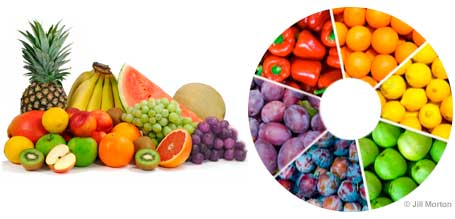
The Colour Wheel
A color circumvolve, based on crimson, yellowish and bluish, is traditional in the field of art. Sir Isaac Newton developed the first round diagram of colors in 1666. Since then, scientists and artists have studied and designed numerous variations of this concept. Differences of opinion about the validity of ane format over some other continue to provoke debate. In reality, any color circumvolve or colour wheel which presents a logically arranged sequence of pure hues has merit.
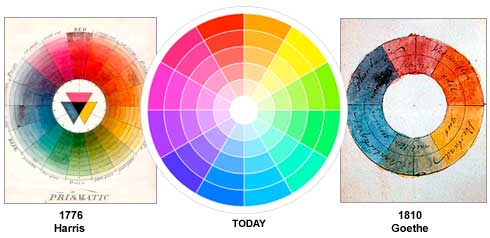
In that location are also definitions (or categories) of colors based on the colour wheel. Nosotros brainstorm with a iii-part color cycle.

Primary Colors: Reddish, xanthous and blue
In traditional color theory (used in paint and pigments), main colors are the 3 paint colors that cannot be mixed or formed past whatever combination of other colors. All other colors are derived from these 3 hues.
Secondary Colors: Green, orange and regal
These are the colors formed by mixing the primary colors.
Tertiary Colors: Xanthous-orange, scarlet-orange, reddish-royal, blue-purple, blue-green & xanthous-green
These are the colors formed past mixing a primary and a secondary color. That'due south why the hue is a two word name, such as blue-dark-green, red-violet, and yellowish-orange.
Color Harmony
Harmony tin exist defined equally a pleasing arrangement of parts, whether it exist music, poetry, color, or even an water ice foam sundae.
In visual experiences, harmony is something that is pleasing to the eye. It engages the viewer and information technology creates an inner sense of guild, a residue in the visual experience. When something is not harmonious, information technology's either boring or cluttered. At i extreme is a visual experience that is so bland that the viewer is not engaged. The human being brain will decline under-stimulating data. At the other farthermost is a visual experience that is so overdone, so chaotic that the viewer can't stand up to look at it. The human brain rejects what it cannot organize, what it cannot understand. The visual task requires that we nowadays a logical structure. Color harmony delivers visual interest and a sense of order.
In summary, extreme unity leads to under-stimulation, extreme complexity leads to over-stimulation. Harmony is a dynamic equilibrium.
Some Formulas for Color Harmony
There are many theories for harmony. The following illustrations and descriptions present some basic formulas.
1. A color scheme based on coordinating colors
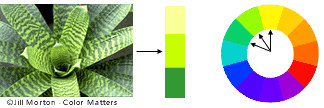
Coordinating colors are whatsoever three colors which are side by side on a 12-role color wheel, such as yellow-light-green, yellowish, and yellow-orange. Usually ane of the three colors predominates.
ii. A color scheme based on complementary colors
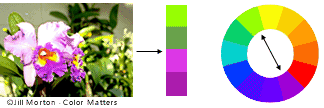
Complementary colors are whatsoever 2 colors which are straight reverse each other, such every bit cherry-red and green and red-royal and yellow-green. In the analogy to a higher place, there are several variations of yellow-green in the leaves and several variations of blood-red-purple in the orchid. These opposing colors create maximum contrast and maximum stability.
3. A color scheme based on nature
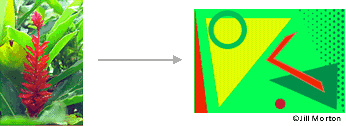
Nature provides a perfect departure point for color harmony. In the illustration above, cherry yellow and dark-green create a harmonious design, regardless of whether this combination fits into a technical formula for color harmony.

Dynamic recipes for color harmony
An e-Course from Jill Morton, Color Matters author & consultant.
Color Context
How color behaves in relation to other colors and shapes is a complex surface area of color theory. Compare the contrast effects of dissimilar color backgrounds for the aforementioned crimson foursquare.
Red appears more than brilliant against a black background and somewhat duller against the white background. In dissimilarity with orange, the red appears lifeless; in contrast with blue-green, it exhibits brilliance. Notice that the red square appears larger on blackness than on other background colors.
Different readings of the same color
If your estimator has sufficient color stability and gamma correction (link to Is Your Calculator Color Blind?) you volition see that the small majestic rectangle on the left appears to have a red-regal tinge when compared to the modest regal rectangle on the right. They are both the same color equally seen in the illustration below. This demonstrates how 3 colors tin can exist perceived equally four colors.
![]()
Observing the effects colors have on each other is the starting betoken for understanding the relativity of color. The relationship of values, saturations and the warmth or coolness of respective hues tin can cause noticeable differences in our perception of color.
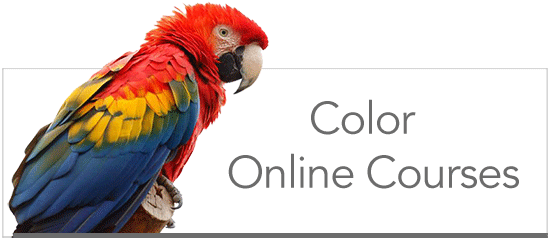
Learn the language of color online
DIY - Learn at your own pace.
Complementary Colors And Analogous Colors,
Source: https://www.colormatters.com/color-and-design/basic-color-theory#:~:text=Analogous%20colors%20are%20any%20three,of%20the%20three%20colors%20predominates.&text=Complementary%20colors%20are%20any%20two,%2Dpurple%20and%20yellow%2Dgreen.
Posted by: matneyfror1958.blogspot.com


0 Response to "Complementary Colors And Analogous Colors"
Post a Comment